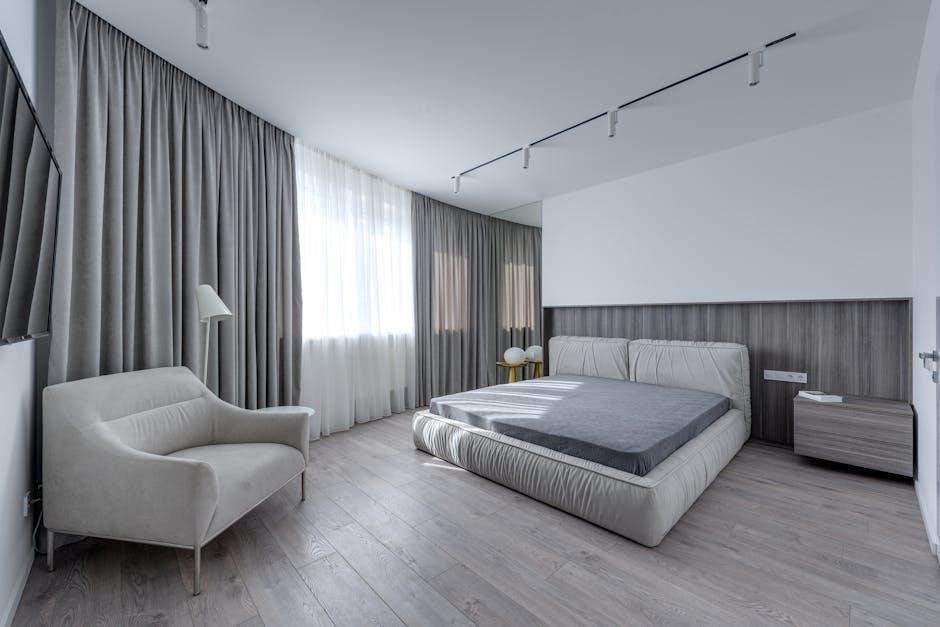
loft bed plans pdf
Loft bed plans offer a practical way to maximize space, combining functionality with style. These comprehensive guides provide step-by-step instructions, materials lists, and blueprints for custom designs. Whether you’re adding a desk, storage, or stairs, loft bed plans empower you to create a functional and beautiful space-saving solution for any room.
What Are Loft Beds?
Loft beds are elevated sleeping platforms designed to maximize space by utilizing vertical room. They are typically raised above the floor, often with a ladder or stairs for access. These beds are popular for their ability to free up floor space underneath, which can be used for desks, storage, or other functional areas. Loft beds are versatile, catering to various needs, from simple designs to complex setups with built-in features like shelves or workstations.
The Benefits of Loft Beds
Loft beds are a space-saving solution ideal for small rooms, offering a practical way to maximize vertical space. They provide a comfortable sleeping area while freeing up floor space for desks, storage, or other functional zones. Loft beds are versatile, suitable for children and adults alike, and can be customized to fit various needs and preferences. Their elevated design not only enhances room functionality but also adds a modern, stylish touch to interiors, making them a popular choice for urban and compact living spaces.
Why Use Loft Bed Plans?
Loft bed plans provide a cost-effective and customizable way to maximize space in any room. They offer detailed instructions, ensuring a sturdy and safe structure. With these plans, you can tailor the design to fit your needs, whether it’s for a child or adult. They also help you avoid costly mistakes and ensure the bed is built to last. Using loft bed plans allows you to create a functional and stylish solution that saves space and enhances your home’s interior. They are a practical choice for DIY enthusiasts and homeowners alike.
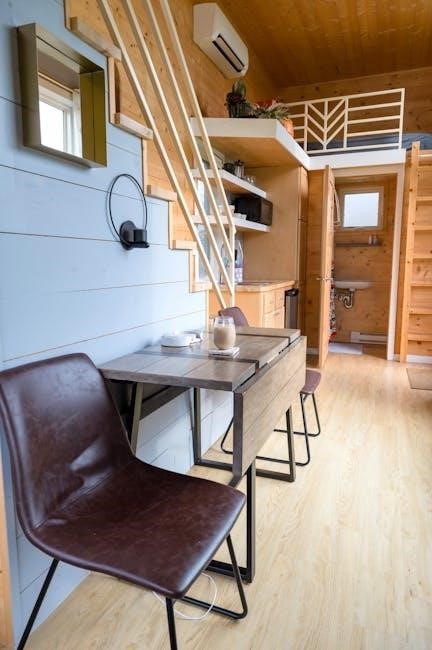
Planning and Design Considerations
Planning and design considerations are crucial for creating functional and safe loft beds. Measure your space, choose a design, and ensure structural integrity for lasting durability and comfort.
Measuring Your Space
Accurate measurements are crucial for a successful loft bed project. Measure ceiling height, floor space, and doorway dimensions to ensure the bed fits comfortably. Consider the room’s layout and the user’s height to avoid hitting their head. Check for any obstructions like windows or vents. Record all measurements to guide your design and material purchases. Proper planning ensures safety, functionality, and a seamless fit for your custom loft bed.
Choosing the Right Design
Selecting the perfect loft bed design involves balancing style, functionality, and space. Consider the room’s purpose, whether it’s for a child or adult, and the desired features like storage, a desk, or stairs. Look for plans that match your skill level and budget. Modern, rustic, or minimalist styles can enhance your room’s aesthetics. Ensure the design aligns with safety standards and structural integrity. The right design transforms your space into a functional and stylish retreat, tailored to your needs and preferences.
Functionality vs. Aesthetics
Loft bed designs often balance practicality and style. Functionality focuses on space-saving features like built-in desks, storage, or stairs, while aesthetics emphasize visual appeal through materials and finishes. Choose designs that align with your room’s decor, whether modern, rustic, or minimalist. Ensure functionality meets everyday needs while aesthetics enhance the room’s ambiance. The right plan harmonizes both, creating a space that is both useful and visually pleasing, tailored to your lifestyle and personal taste.
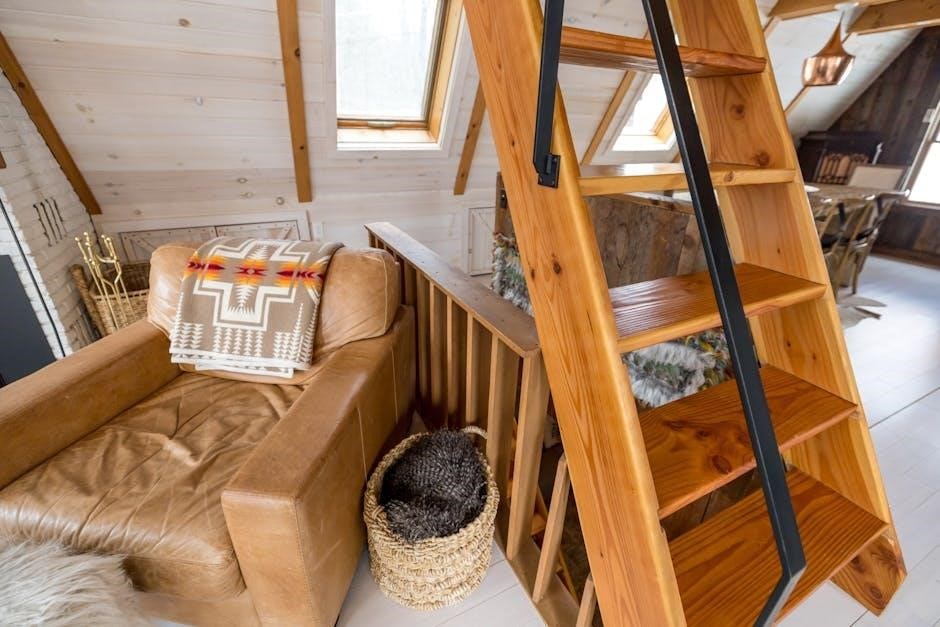
Safety Features in Loft Bed Design
Safety is paramount in loft bed design, featuring guardrails, sturdy ladders, and weight capacity checks. These elements ensure stability and protection for users of all ages, blending functionality with style.
Guardrails and Safety Rails
Guardrails are essential for safety in loft bed designs, preventing falls and ensuring stability. They should be installed along the open sides of the bed, typically at least 12 inches above the mattress. Durable materials like wood or metal are recommended. Securely attach rails to the bed frame to avoid wobbling. For added safety, ensure the guardrails extend beyond the ladder or staircase. Regular inspections and maintenance are crucial to maintain their integrity and protect users, especially children, from accidents.
Ladder Safety
Ladder safety is crucial for preventing accidents. Ensure the ladder is sturdy, with a secure attachment to the bed frame. Choose materials like strong wood or metal. The ladder’s angle should be moderate to prevent slipping. Pre-drill holes for rungs to ensure stability. Use non-slip coatings or rubber pads on steps for better grip. Regularly inspect the ladder for damage. Consider adding side rails for extra safety. Always test the weight capacity before use. These steps ensure safe and reliable access to the loft bed.
Weight Capacity and Structural Integrity
Ensuring the weight capacity and structural integrity of your loft bed is essential for safety. Use high-quality lumber and hardware to support the intended load. The bed frame must be sturdy, with reinforced joints to prevent wobbling. Calculate the maximum weight the bed can hold, considering both the mattress and occupants. Regular inspections and maintenance can help maintain stability over time. Always follow the plan’s specifications and use durable materials to ensure long-term reliability and safety for users. Proper construction guarantees a secure and stable loft bed.
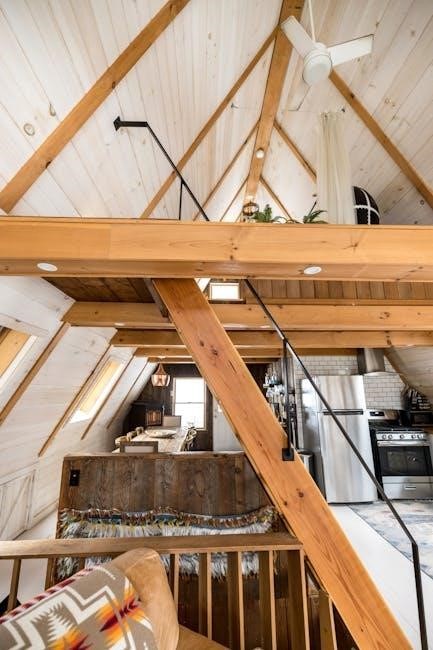
Materials and Tools Needed
Materials: Construction-grade lumber (2x4s, 2x6s), screws, bolts, wood glue, and sandpaper. Tools: Drill, saw, wrench, measuring tape, and level. Ensure all items are durable and suitable for the project.
Lumber Selection
Choosing the right lumber is crucial for durability and safety. Opt for sturdy, construction-grade materials like 2x4s and 2x6s, which provide excellent support. For a full-size loft bed with a desk, expect to spend around $200 on lumber, paint, and fasteners. Select wood that is straight and free of knots to ensure stability. Consider pre-drilling to avoid splitting and use weather-resistant options if needed. Proper lumber selection ensures a sturdy, long-lasting structure for your loft bed project.
Hardware Requirements
Essential hardware includes bolts, screws, and brackets to secure frames and ladders. Use high-strength lag bolts for stability and galvanized screws for weather resistance. Metal brackets reinforce joints, while wood screws ensure tight connections. For ladders, hinges and handles add functionality. Proper hardware ensures structural integrity and safety, preventing wobbling or collapse. Always follow plan specifications to choose the right hardware for your loft bed design, ensuring durability and reliability for years to come.
Essential Tools for the Job
Begin with a circular saw for precise lumber cuts and a drill for secure fastening. Sandpaper smooths wood surfaces, while a tape measure ensures accuracy. Use clamps to hold pieces steady during assembly. A level guarantees everything is perfectly aligned, and wrenches tighten bolts securely. Safety gear like gloves and goggles protect during the process. Having these tools ready streamlines the building process, helping you construct a sturdy and safe loft bed efficiently.
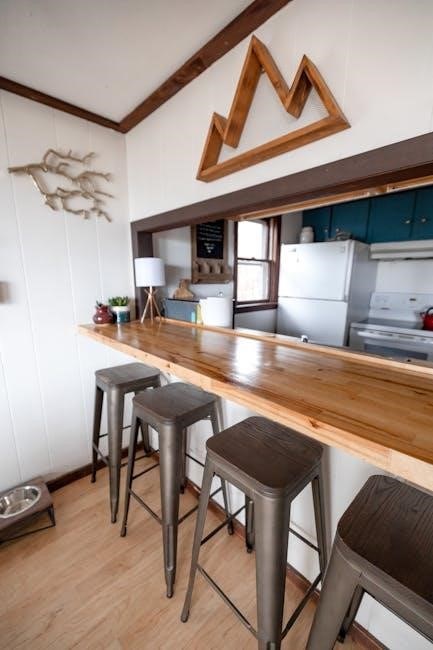
Step-by-Step Instructions
Start by assembling the frame, ensuring all pieces fit securely. Next, attach the ladder and test its stability. Add a built-in desk for functionality, then finalize the installation with proper alignment and tightening of all components for a sturdy finish.
Assembling the Frame
Begin by preparing all lumber according to your plan. Cut the legs and side rails to the specified lengths. Use wood screws to secure the frame together, ensuring corners are square. Attach support slats for the mattress, spacing them evenly for stability. Drill pilot holes to prevent splitting. Bolt the side rails to the legs for added strength. Double-check alignment and tighten all connections. Sand rough edges for safety before moving on to the next step.
Building the Ladder
Construct the ladder by cutting the side rails and rungs to size. Assemble the sides using wood screws, ensuring the rungs are evenly spaced for safe footing. Sand all edges for smoothness. Attach the ladder to the loft bed frame securely, ensuring it is stable and aligned properly. Use brackets or hinges for adjustability if desired; Test the ladder’s weight capacity and make adjustments as needed for optimal safety and durability. Ensure all connections are tight and sturdy.
Adding a Built-In Desk
Integrate a built-in desk beneath your loft bed for a functional workspace. Measure the area to ensure the desk fits seamlessly. Cut the desktop to size, using durable materials like plywood or MDF. Attach legs or support brackets securely to the bed frame. Add shelves or drawers for storage if desired; Sand and finish the desk to match the bed’s style. Ensure proper alignment and stability before final installation for a cohesive and practical design that maximizes space efficiently. This feature enhances productivity while maintaining a clean, organized look.
Final Assembly and Installation
Assemble the loft bed frame according to the plan, ensuring all joints are secure and sturdy. Attach the bed deck and guardrails, then install the ladder or staircase. Double-check the weight capacity and structural integrity. Sand all surfaces and apply a finish for a polished look. Install any additional features like drawers or shelves. Finally, place the mattress and bedding, ensuring everything is safe and stable. Proper installation guarantees a durable and functional loft bed for years of enjoyment.
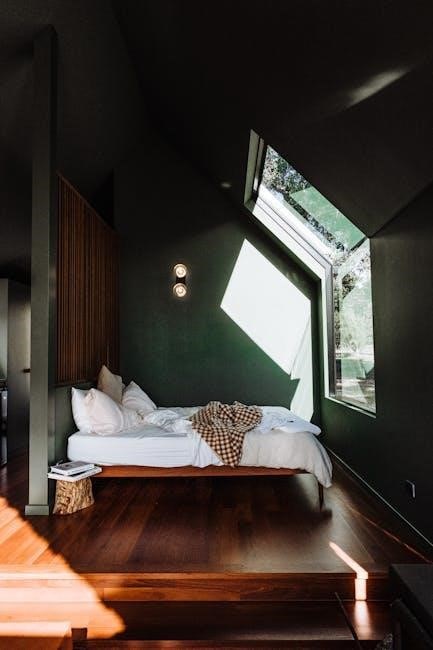
Additional Features
Enhance your loft bed with storage solutions, desk integration, and staircase options. These features maximize functionality and add a touch of modern aesthetics to your space.
Storage Solutions
Loft bed plans often incorporate clever storage solutions to maximize space. Built-in shelves, drawers, or cabinets can be integrated into the design. Consider adding storage bins or baskets under the bed for linens or personal items. Some plans include Ottomans with hidden compartments or bed skirts with pocket storage. These practical features ensure your loft bed is both functional and organized, making the most of the available space while keeping belongings within easy reach. This enhances the overall utility of your loft bed setup.
Desk Integration
Desk integration is a popular feature in loft bed designs, offering a functional workspace beneath the bed. Plans often include built-in desks with ample surface area for laptops, books, and office supplies. Some designs feature adjustable height settings or foldable options to save space when not in use. This combination of a loft bed and desk creates a versatile environment, perfect for students, home offices, or small living spaces, ensuring productivity and comfort in one cohesive setup. The desk seamlessly blends with the bed’s structure, enhancing the room’s functionality and style.
Staircase Options
Staircase options for loft beds offer a convenient and stylish way to access the elevated sleeping area; Many plans include traditional staircases with sturdy steps and handrails for safety. Spiral staircases are also popular for space-saving designs. Some designs feature storage compartments within the stairs for added functionality. Whether you prefer modern or rustic styles, staircase options enhance both the practicality and aesthetic appeal of your loft bed, ensuring easy and safe access while complementing the room’s decor.
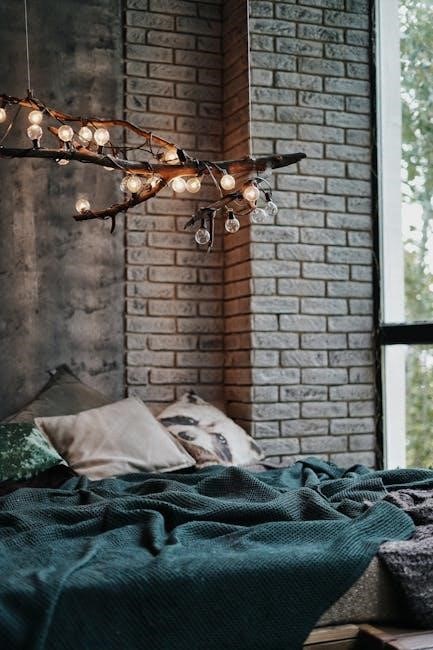
Budgeting and Cost Management
Effective budgeting ensures your loft bed project stays cost-efficient. Plan carefully, comparing material prices and optimizing your design to minimize expenses while maintaining quality and functionality.
Estimating Material Costs
Estimating material costs for your loft bed project is crucial to stay within budget. Start by listing all required materials, such as lumber, screws, and paint. Calculate quantities based on your design and measure carefully to avoid waste. Research current prices at hardware stores or online to get accurate estimates. For example, construction-grade lumber for a full-size loft bed may cost around $75 to $200, depending on the type and location. This step ensures you’re prepared financially and can proceed without unexpected expenses.
Minimizing Expenses
Minimizing expenses for your loft bed project involves strategic planning and smart shopping. Opt for cost-effective materials like standard lumber sizes to reduce waste and costs. Repurpose or buy second-hand hardware to save on screws and bolts. Additionally, consider simpler designs that require fewer materials, such as avoiding intricate details or advanced features. Shopping during sales or using coupons can also lower your total expenditure. These tactics help you build a functional and stylish loft bed without breaking the bank.
Long-Term Value
A well-constructed loft bed from a reliable PDF plan offers long-term value by providing durable, adaptable furniture for years. High-quality materials and sturdy construction ensure the bed remains stable and safe, enduring through various uses. Its space-saving design adds versatility, accommodating different needs over time, such as transitioning from a child’s bedroom to a guest area. Investing in a detailed plan and proper materials ensures your loft bed remains a practical and stylish asset, enhancing your home’s functionality and aesthetics for the long haul.
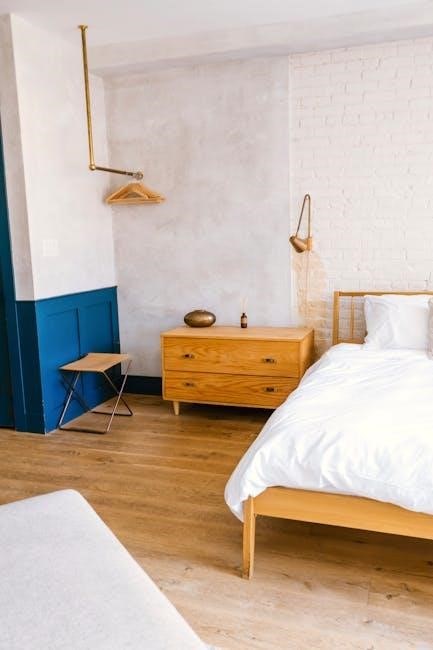
Troubleshooting Common Issues
Loft bed plans PDFs often include guides for addressing common issues like wobbling frames or misaligned ladders. Proper assembly and material selection ensure stability and safety, preventing structural problems and enhancing long-term functionality. Detailed steps and expert advice help DIY builders identify and fix issues early, ensuring their loft bed remains sturdy and reliable for years to come.
Addressing Wobbling Frames
Wobbling frames are common issues in loft bed construction. To fix this, ensure all legs are evenly placed and tightly secured to the floor. Check for loose bolts or screws and tighten them firmly. Adding support brackets or reinforcing the frame with additional lumber can enhance stability. If the floor is uneven, use levelers or shims to balance the structure. Loft bed plans PDFs often include tips for securing frames and preventing wobbling, ensuring a sturdy and reliable final product.
Fixing Ladder Alignment
Ensure the ladder is properly aligned with the loft bed frame by checking the rung spacing and angle. Use a level to verify the ladder is straight and secure it firmly to the bed frame. Tightening the bolts at the connection points can improve stability. If misalignment persists, adjust the ladder’s position or add support brackets for better alignment. Proper alignment ensures safe and easy access to the loft bed, enhancing both functionality and safety.
Ensuring Stability
Stability is crucial for loft beds. Use high-quality lumber and hardware to build a sturdy frame. Ensure all joints are secure and tightened properly. Adding support brackets or crossbeams can reinforce the structure. Regularly inspect the bed for any signs of wobbling or weakness. Anchoring the bed to the wall prevents shifting, especially in homes with uneven floors. A stable loft bed provides peace of mind and ensures long-term durability, making it safe for everyday use and reliable over time.
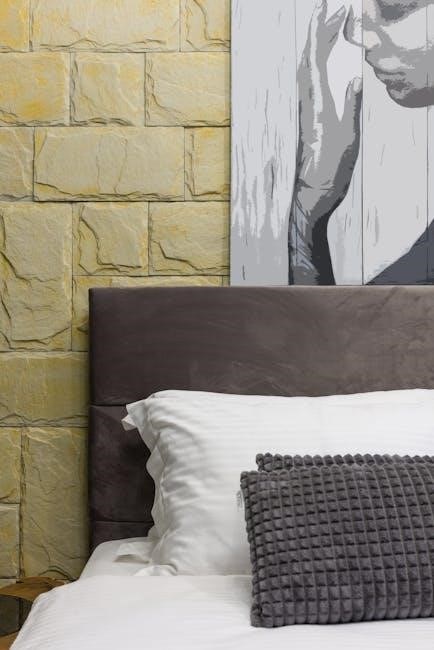
Advanced Loft Bed Projects
Advanced loft bed projects include custom designs, multi-level configurations, and modern features like built-in storage or desks, offering creative solutions for maximizing space and functionality.
Custom Loft Bed Designs
Custom loft bed designs allow you to tailor the bed to your specific needs and preferences. From modern minimalist styles to rustic finishes, you can choose materials and features that match your decor. Many plans include options for built-in desks, storage compartments, or even multi-level configurations. Advanced designs might incorporate stairs instead of ladders for easier access. With custom loft bed plans, you can create a unique, functional, and aesthetically pleasing solution that maximizes your space while reflecting your personal style.
Multi-Level Loft Beds
Multi-level loft beds are a space-saving solution for shared rooms or small areas. These designs often feature multiple platforms or tiers, allowing for beds, desks, or storage on different levels. Advanced plans may include staircases or ladders for easy access between levels. By utilizing vertical space, multi-level loft beds create functional zones within a single room, making them ideal for siblings or roommates. They offer a practical and efficient way to maximize space while maintaining comfort and accessibility for all users.
Incorporating Modern Features
Modern loft bed designs often include innovative features like built-in lighting, USB ports, and sleek storage solutions. Advanced plans may incorporate foldable desks, hidden compartments, or adjustable shelving. Some designs even integrate smart home technology, such as LED lighting systems or charging stations. These modern elements enhance functionality while maintaining a contemporary aesthetic. By blending practicality with cutting-edge features, modern loft beds cater to diverse needs, offering a blend of style, comfort, and advanced convenience for today’s lifestyles.
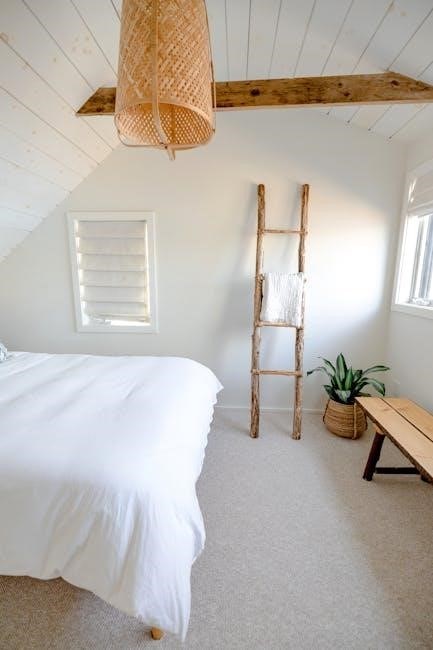
Free Loft Bed Plans PDF Resources
Free loft bed plans PDFs offer detailed DIY guides, including materials lists, exploded views, and step-by-step instructions. These resources help you create custom, space-saving designs effortlessly.
Where to Find Free Plans
Free loft bed plans are widely available online, offering detailed blueprints and guides. Websites like Pinterest, Reddit, and DIY blogs provide step-by-step instructions. Platforms like Etsy and specialized woodworking sites also offer downloadable PDFs. Many online communities share custom designs, from basic to advanced projects. These resources often include materials lists, exploded views, and assembly tips. Whether you’re a novice or experienced builder, these free plans can help you create a functional and stylish loft bed tailored to your needs.
Downloading and Printing PDFs
Downloading loft bed plans as PDFs is straightforward. Look for reputable DIY websites, forums, or marketplaces like Etsy. Ensure the file is in PDF format for clarity. Before printing, check the paper size matches the plan’s requirements. Use a high-quality printer for crisp details. Verify scaling settings to maintain accuracy. Save a digital copy for easy access and future adjustments. Always review the plans before printing to ensure all pages are included and legible.
Using Online Blueprints
Online blueprints provide detailed layouts for constructing loft beds. These plans often include exploded views, materials lists, and precise measurements. Utilize interactive features like zoom and rotate to visualize the project. Ensure compatibility with your software or device for seamless viewing. Many blueprints are customizable, allowing adjustments to fit specific spaces or preferences. Follow the step-by-step instructions carefully to ensure accuracy and safety. Regularly refer back to the blueprint during construction to maintain alignment with the design.
With careful planning and execution, loft bed plans can transform your space into a functional and stylish retreat. Enjoy your new space-saving creation!
Final Tips for Success
For a successful loft bed project, ensure thorough planning and precise measurements. Use high-quality materials and follow step-by-step instructions carefully. Double-check all connections for stability and safety. Consider adding features like built-in storage or a desk to maximize functionality. Always prioritize weight capacity and structural integrity to ensure durability. Finally, inspect the finished bed for any wobbles or alignment issues before use. These steps will help you create a safe, stylish, and functional loft bed that meets your needs.
Enjoying Your New Loft Bed
Once your loft bed is complete, you’ll enjoy the extra space and functionality it provides. Whether it’s for relaxation, work, or play, a well-designed loft bed enhances any room. The sense of accomplishment from building it yourself adds to the satisfaction. Personalize it with bedding, lighting, or decor to create a cozy retreat. Your new loft bed will not only maximize space but also become a focal point of comfort and style in your home, offering years of enjoyment and utility.
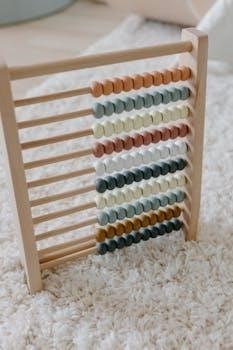

Leave a Reply
You must be logged in to post a comment.